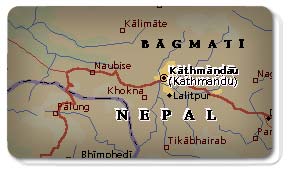White Water and Wooden Windows - Contrasting Images of Nepal
 | Map of where we are. |
Nepal is a country of extremes. Beauty and ugliness, violence and peace, foulness and elegance attract and repel continually confusing the senses. Outdoor enthusiasts bungee jump, raft, bike or trek. Architectural masterpieces are found around every bend. Yet, Nepal, one of the poorest countries of the world, suffers from the typical problems of any developing country.
 | Click to Enlarge. |
Even though only slightly larger than Arkansas, Nepal's elevation varies from just above sea level to the highest point on earth - 70 to 8,848 meters (230 to 29,000 feet). From the jungle of the lowland Terai to the Himalayas, Nepal is probably the only country in the world where you can scale Mount Everest, see a tiger in the wild and be at risk of catching both Malaria and Altitude Sickness.
During a nine-day rafting trip down the Sun Khosi river, Will and I were able to experience the tranquillity and violence of natural Nepal. The Sun Khosi is recognized as one of the 10 best white water trips in the world, class 3-5 rapids are numerous and the scenery is just as impressive. It winds 270 km from the hills just outside Kathmandu down to the Eastern Terai.
 | Click to Enlarge. |
Deep canyons and thick jungle towered over us as we began our journey. Vibrant birds: turquoise kingfishers, brilliant white long-tailed budgies and stucco herons, buzzed by as we leisurely floated down river.
 | Click to Enlarge. |
Our group included seven: Will and I, a Princeton student on a year off, two South African ex-army mates, a British woman, and our Nepali captain, Assish. We were Team Kingfisher. I gave us this name because the bright blue raft, yellow helmets and orange lifejackets that made us stick out like a beacon on the river, resembled the colors of the birds we so often saw fly by.
 | Click to Enlarge. |
The first day was spent floating in the raft or alongside it in the cool river staring up at the tiny villages and dense tree cover. There were no man made sounds, no roads, only the rushing river, birds and wind.
 | Click to Enlarge. |
Our peaceful journey turned violent on the second day. We hit our first whitewater, the Harkapur, a class five rapid named after the adjoining village. As we scouted from the rocks above we saw giant erratic waves crashing into each other on the left-hand side of the river. On the right was a 12-foot massive hydraulic hole. A hydraulic hole is white water phenomenon where the water powerfully sucks you down in whirlpool fashion. We chose to take the path of the waves. The Sun Khosi not 100 meters up river had been as placid as a pond. As we boarded back in the raft to face the challenge, my knees buckled fearing the power we were about to encounter.
 | Click to Enlarge. |
"Paddle hard! Back left! All Forward team! Go Go!" Assish barked commands as Team Kingfisher approached our first test. The raft flew up and down, water poured in from the splashing waves. I looked up. We were facing an eight-foot standing wave. There was a good possibility the raft might flip. "Paddle forward, go go!" The front of the raft jettisoned up at what seemed a ninety-degree angle and then crashed hard. I flew up with it but landed safely. The raft did not flip. We all yelled with delight and exhilaration. We had passed our first class five rapid.
 | Click to Enlarge. |
In the afternoons we would take a break for lunch, lazing in the hot sun or frolicking in the refreshing river. One day, we stopped at a small bank. Up a winding jungle path, we spied a waterfall and small lagoon. Sheets of freezing water pummeled down a shale rock face. We took turns standing underneath for an impromptu message and shower.
Each evening we camped on sandy shores by the beach. The river went gently by. Cows and villagers stopped in to say hello. We relaxed at riverside and recounted our day's adventures. Staring up at the night sky, it seemed that the whole cosmos was visible. Wishes were made on numerous shooting stars. Fireflies blinking in concert in the neighboring treetops could have easily been mistaken for tiny magical fairies.
 | Click to Enlarge. |
One night though, the sky quickly turned black. The air turned humid and still. We rushed to secure the gear and retire to our tents away from the impending rain. Our camp was on a small patch of sand backing up to a hill. The river rushed below us. Just beyond the campsite was the Rhino Rock rapid. A huge rock, supposedly resembling a rhino, displaced water into huge waves and crashing white water on either side. To the left of our campsite a small rocky stream spilled into the Sun Khosi.
Lightning cracked overhead. The monsoon rain pummeled our tiny two-person tent. A constant low and loud rumble could be heard. Will speculated it was thunder; to me it sounded like an avalanche. In the pitch black we huddled together hoping we would not end up in the river.
The next morning the whole team surveyed the area. Huge gashes, eroded by the rain, were sliced into the sand around our tents. Luckily the stakes had held. Rhino Rock had disappeared. The water level had risen at least five feet. The rumbling I had heard had been a landslide, giant boulders pummeling into the stream next to our site. The stream was now a rushing river. We packed up our gear thankful to have made it through the night.
|
